Looking to boost collaboration, trust, and morale in your team? Discover proven team-building activities tailored for remote, hybrid, and in-office groups—all fact-checked and trusted by HR professionals. You’ll find clear explanations, helpful visuals, and step-by-step instructions— just strategies that get real results.
Why read this?
- Every activity is backed by current workplace data
- Engage any group: choose icebreakers, creativity games, or trust exercises fit for every team size.
- Each activity supports the 7 C’s of great teamwork—communication, cooperation, and more—so you can address exactly what your group needs most.
Explore simple tips on picking the right games, learn how team-building benefits your workplace, and see how other leaders keep their teams connected.
Ready to energize your staff?
What are the 7 C’s of team building?
Great team-building activities never happen randomly. The most effective programs use the 7 C's framework. These essential elements turn simple games into meaningful experiences that build stronger workplace relationships.
The 7 C's create a roadmap that delivers real results instead of just passing time. Your team will remember these principles long after the activity ends because they work together seamlessly.
- Communication serves as the cornerstone of every successful team. The right team-building exercises push people to express ideas clearly and listen well. Activities that need precise instructions and feedback help build communication skills that your team can use at work.
For example, "Back-to-Back Drawing" makes a perfect example - one person describes an image while another draws it using only verbal directions.
- Cooperation goes beyond simple participation. The best team-building exercises help members put the team's success ahead of personal goals.
For example,Games like "Human Knot" or "Pipeline" show how each person's actions affect the whole group. Teams learn the value of unity over internal competition.
- Coordination helps teams sync their efforts and timing. Remote teams working in different time zones need this skill even more. Relay races and synchronized challenges teach teams the art of timing their actions for better results.
- Cohesion acts as emotional glue for teams. While cooperation shows how people work together, cohesion reveals how they feel about their team.
For example, Fun team building activities like "Two Truths and a Lie" or "Personal Scavenger Hunt" create genuine bonds that make teams stronger.
- Commitment turns short-term alignment into long-term dedication. Teams grow stronger when activities challenge them to persevere. Look for games that get progressively harder and reward persistence. Teams feel accomplished when they overcome obstacles together.
- Collaboration stands apart from cooperation. The focus shifts to creative problem-solving rather than basic teamwork. The best team-building activities present complex challenges with many possible answers. Teams must combine different viewpoints to succeed.
For example, Escape rooms and design challenges help build these skills naturally.
- Creativity completes the framework by sparking innovative thinking. Teams learn to think differently when activities break normal patterns and reward new solutions. Building structures with unusual materials or solving problems with artificial limits helps teams adapt to change.
Your next team event should match activities to these 7 C's. The most effective team-building games don't need every element. Choose activities that target the specific C's your team needs to improve right now.
These principles turn simple group activities into valuable investments. T.eams develop real workplace skills while having the fun they want.
Icebreaker Games to Kickstart Connection
Breaking the ice means more than just being polite—it's a crucial first step to building genuine team connections in the 2025 workplace. Teams need these quick-start activities to warm up before tackling bigger challenges. This helps new members and those who don't often meet.
1. Two Truths and a Lie
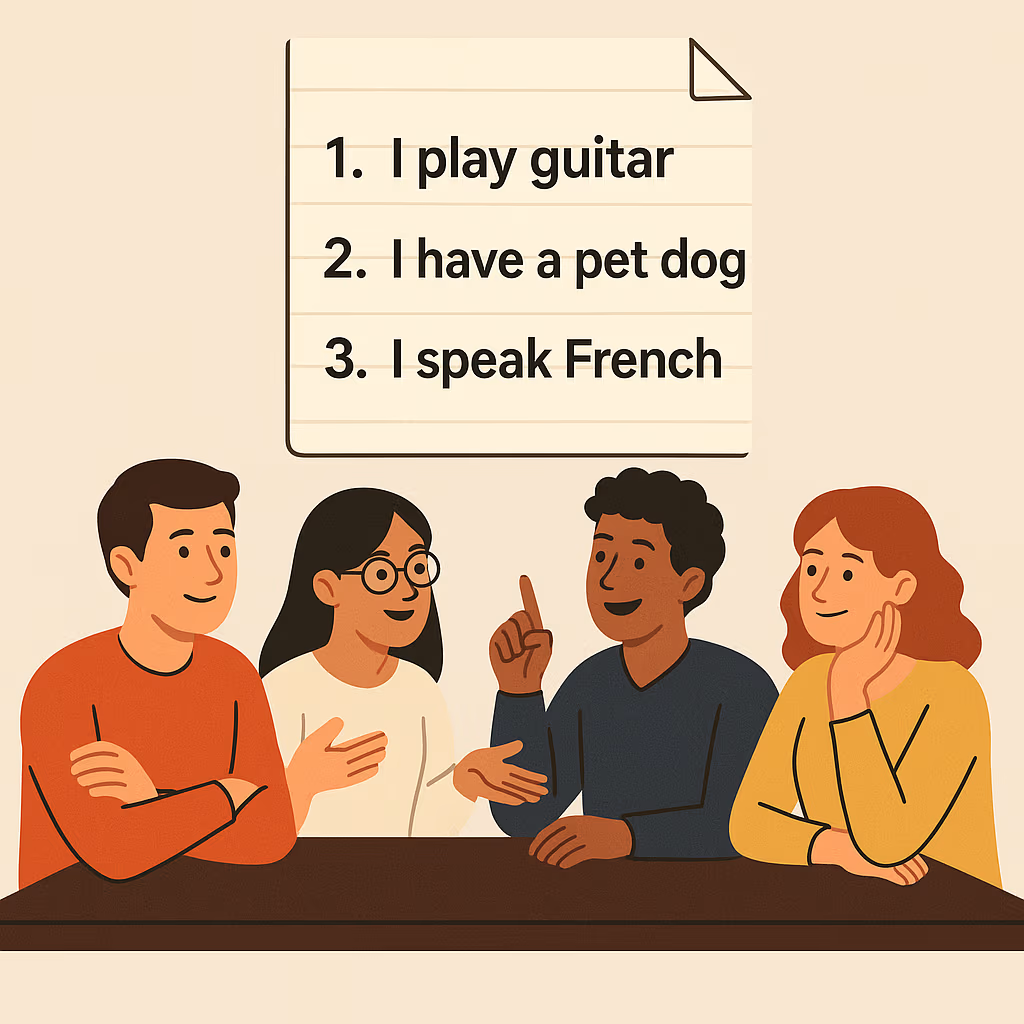
Overview:
A classic icebreaker where each team member shares three statements about themselves—two that are true and one that is a lie. The rest of the group tries to guess which statement is the lie. This activity works well for building trust and sparking interesting conversations, as people often reveal surprising or funny facts about themselves.
How to Play:
- Give everyone 2–3 minutes to think of two true statements and one believable lie about themselves.
- Each person takes a turn sharing their three statements with the group.
- The group discusses and votes on which statement they think is the lie.
- The person reveals which statement was false, often leading to laughter or further stories.
- Continue until everyone has had a turn.
Materials Needed:
None (just pen and paper if people want to jot down their statements).
Ideal Group Size & Setting:
Works best with 3–15 people. Suitable for in-person, remote, or hybrid teams.
Why It Works:
Encourages creativity and vulnerability, helps team members learn new things about each other, and builds a relaxed, open atmosphere.
2. Penny for Your Thoughts
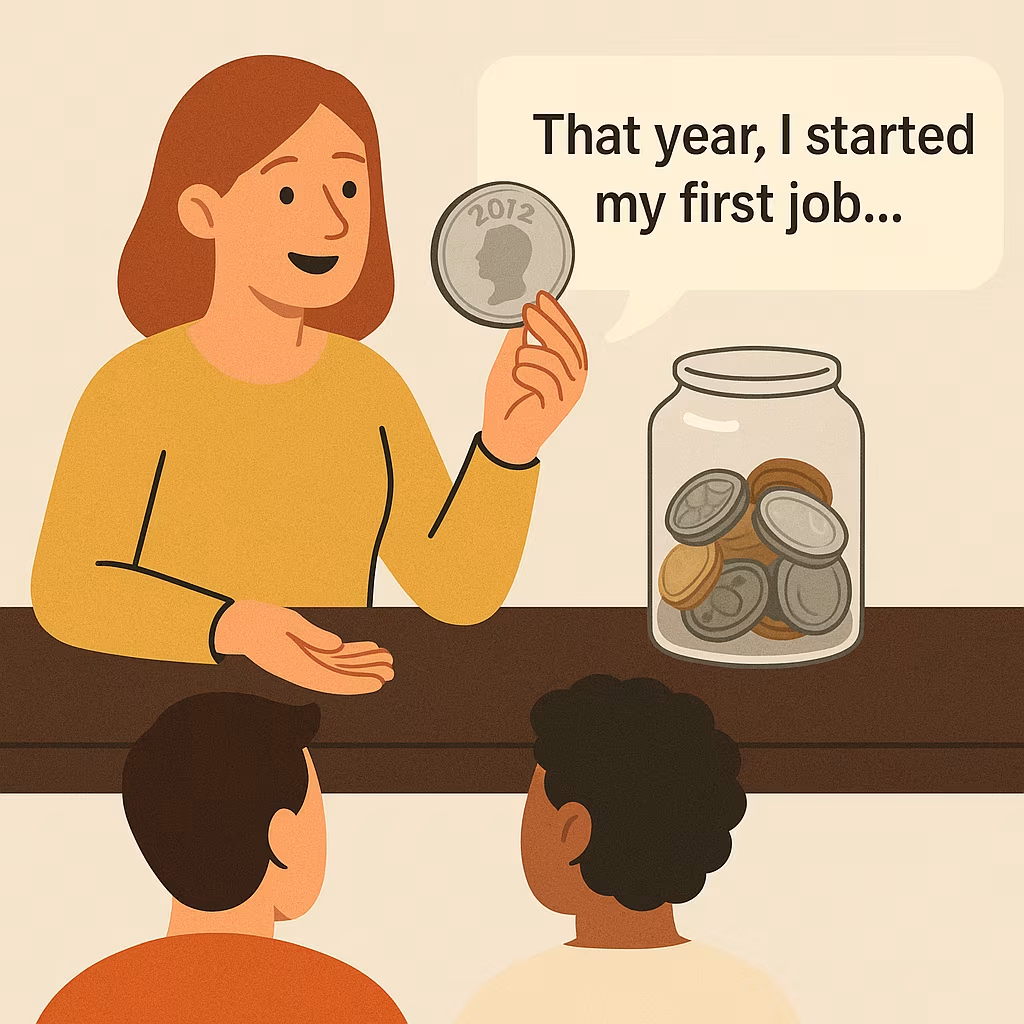
Overview:
A storytelling activity where each participant picks a coin (or any dated item) and shares a meaningful memory from the year on the coin. This activity helps people open up and discover shared experiences, making it easier to connect on a personal level.
How to Play:
- Collect coins with various years (not older than the youngest team member).
- Place the coins in a jar or container.
- Each participant draws a coin and shares a memory or significant event from the year on their coin.
- If someone picks a year before they were born, they can share their earliest memory or something meaningful from their childhood.
Materials Needed:
A collection of coins (or any dated objects) and a container.
Ideal Group Size & Setting:
Works for any group size. Best for in-person or hybrid teams, but can be adapted for remote teams using digital images of coins.
Why It Works:
Promotes personal storytelling, helps team members find common ground, and builds empathy and trust within the group.
3. The One-Word Icebreaker
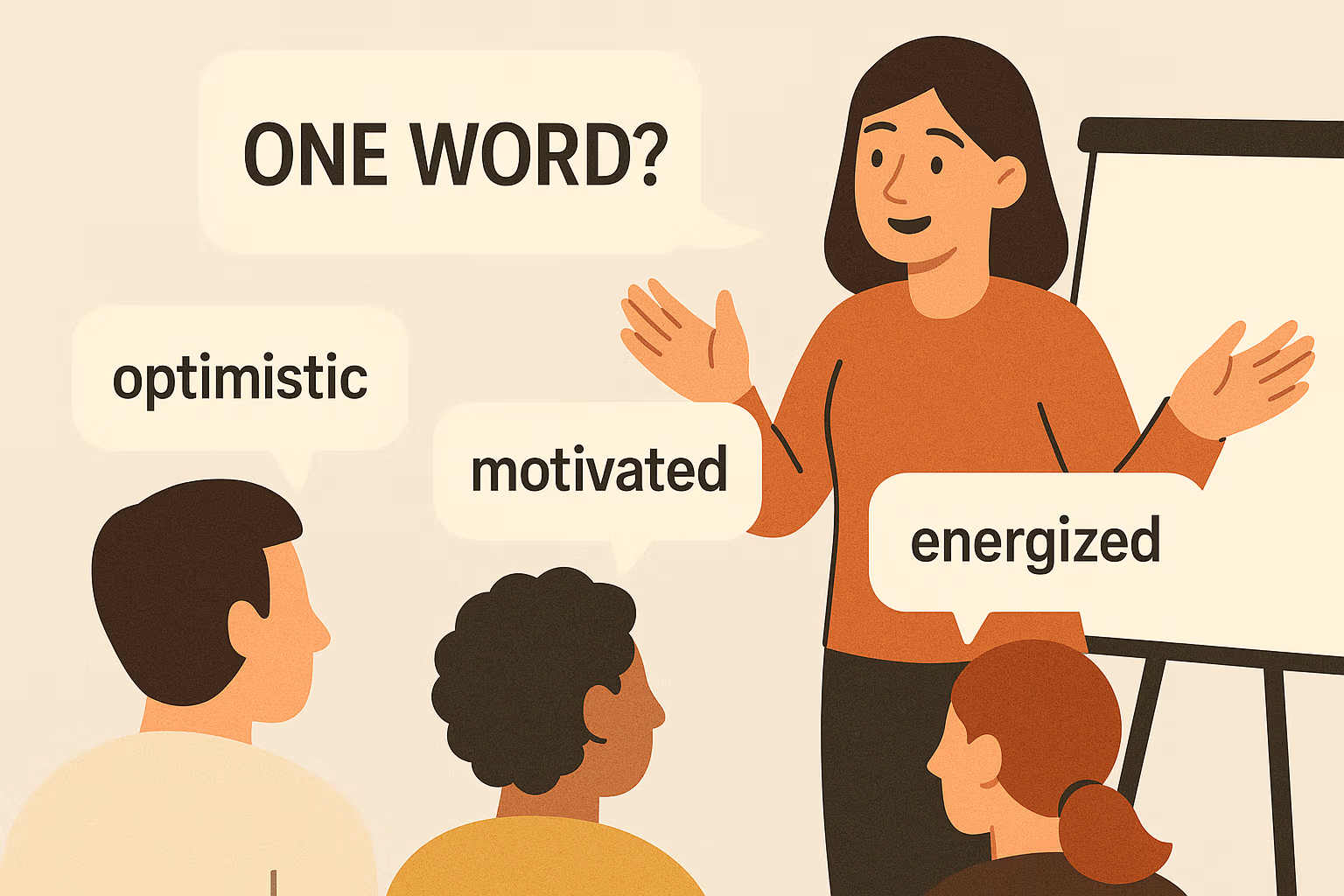
Overview:
A quick and simple activity where each team member shares one word that describes how they’re feeling, their current state of mind, or their reaction to a topic. This gives everyone a voice and provides a snapshot of the team’s mood.
How to Play:
- Ask each team member to think of one word that represents how they feel or their reaction to a meeting topic.
- Go around the group and have everyone share their word.
- Optionally, you can build a sentence together, with each person adding a word in turn, related to the meeting’s theme.
Materials Needed:
None.
Ideal Group Size & Setting:
Any size group. Works well for in-person, remote, or hybrid teams.
Why It Works:
Breaks the ice quickly, encourages participation from everyone, and helps leaders gauge the team’s mood or mindset.
What Do We Have in Common?
Strangers become friends by discovering shared experiences. Small groups of 4-6 people find 10 things they share beyond obvious facts (no "we all work here").
Teams naturally dig deeper as they move past basic similarities. Turn it into a contest by giving a small prize to the group that finds the most unique commonalities quickly.
4. Salt and Pepper Match-Up
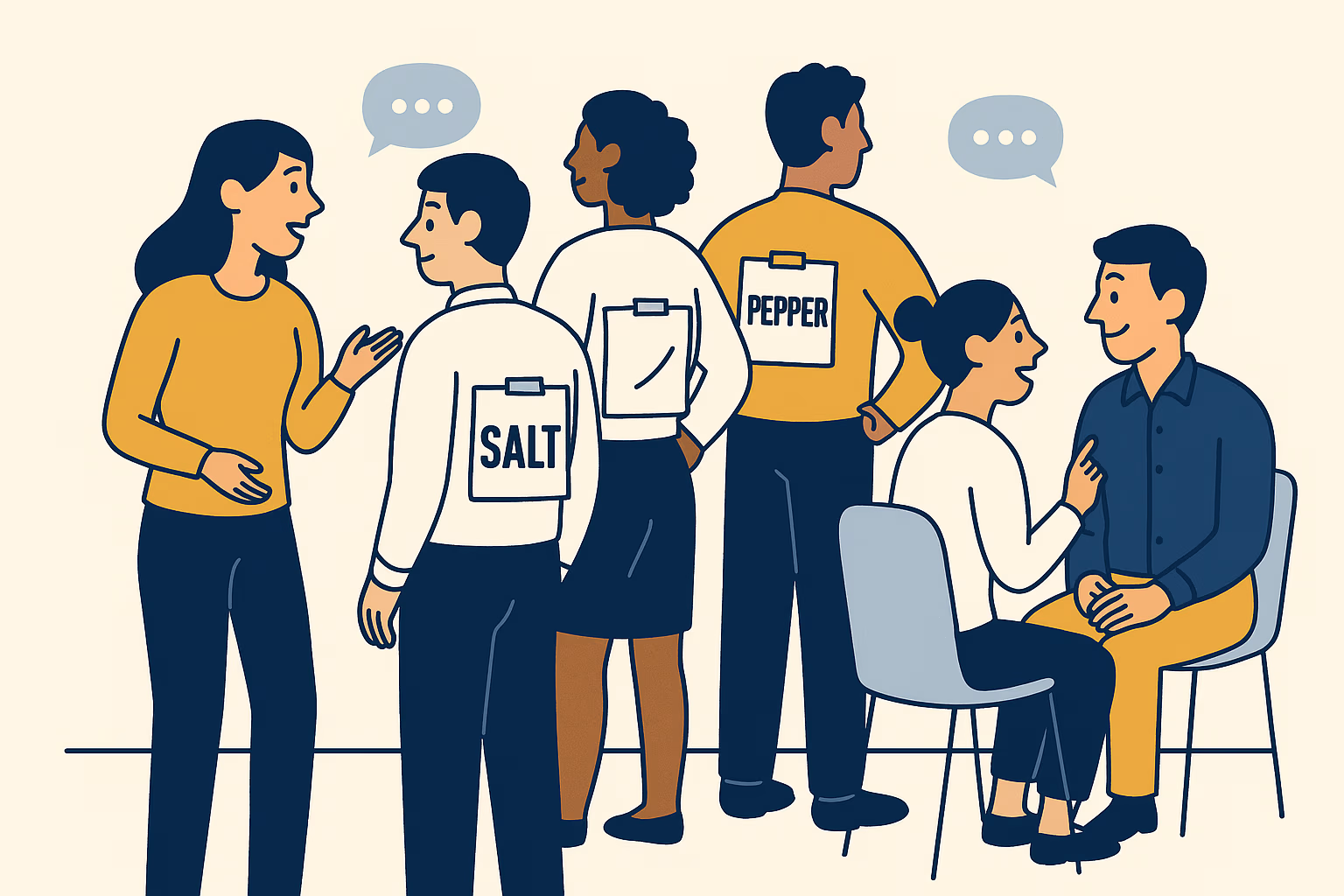
Overview:
This fun detective-style icebreaker helps team members connect quickly through a playful challenge. Each person is given half of a famous pair (like “salt” or “pepper,” “peanut butter” or “jelly”) taped to their back. The goal is to figure out their own identity by asking yes/no questions, then find their matching partner. Once paired, teammates get to know each other better by sharing a few interesting facts.
How to Play:
- Write well-known pairs (such as “salt and pepper,” “peanut butter and jelly,” “Batman and Robin”) on separate slips of paper.
- Tape one slip to each participant’s back, making sure they can’t see it.
- Everyone mingles and asks yes/no questions to others to figure out what’s written on their own back.
- Once someone guesses their identity, they search for their matching pair.
- Partners sit together and share 3–5 interesting facts about themselves.
Materials Needed:
- Slips of paper with famous pairs
- Tape
- Pens (optional, for writing facts)
Ideal Group Size & Setting:
Works best with 6–30 people. Perfect for in-person or hybrid teams where people can move around and interact.
Creative Team Building Activities for the Modern Workplace
Your team's hidden talents come alive through creative activities that solve ground workplace challenges. These team-building exercises do more than typical games. They promote creativity and bring innovation into daily work.
5. Build-a-Shake

Overview:
This lively, hands-on activity gets teams laughing and builds trust in a memorable way. Team members pair up, and one person wears a blindfold while their partner selects ingredients to create a custom shake. After both partners make shakes for each other, they drink their creations together. The fun comes from trusting your teammate’s choices and sharing the results—good or bad!
How to Play:
- Divide the group into pairs.
- Set up a table with a variety of shake ingredients (yogurt, fruit, juice, etc.).
- One person in each pair is blindfolded while their partner chooses ingredients and blends a shake for them.
- Switch roles so both partners make a shake for each other.
- Both partners drink their shakes at the same time.
- Encourage everyone to share their reactions and laugh together.
Materials Needed:
- Blindfolds
- Blenders
- Cups
- Assorted shake ingredients (yogurt, fruits, juices, etc.)
- Trash cans (for any “interesting” shakes)
Ideal Group Size & Setting:
Best for groups of 6–20. Works well in-person, ideally in a kitchen or break room.
Why It Works:
Breaks down barriers, builds trust, and creates shared memories through a playful, slightly daring experience.
6. Magazine Story
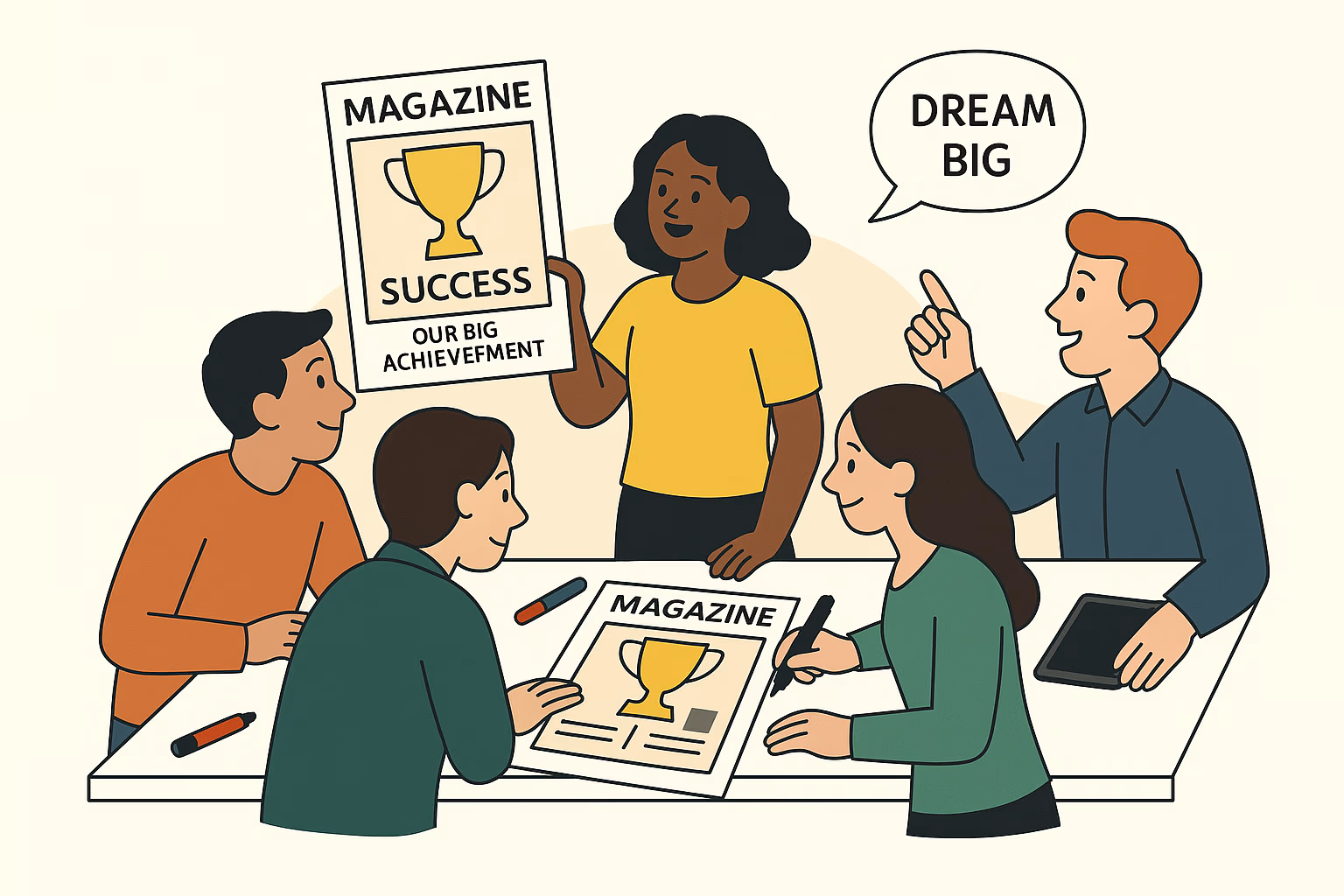
Overview:
Teams imagine their future success by creating a fictional magazine cover story about a big accomplishment. Groups work together to design a magazine cover, complete with headlines, quotes, and sidebars, showcasing their team’s achievements as if they’ve already happened. This visualization exercise boosts motivation and team spirit.
How to Play:
- Divide into teams of 3–6 people.
- Give each team a magazine cover template and examples for inspiration.
- Teams brainstorm and write a story about their future success, filling in the cover with headlines, quotes, and images.
- Display the finished covers in a common area or share them digitally.
Materials Needed:
- Magazine cover templates
- Markers, pens, or digital design tools
- Sample magazines for inspiration
Ideal Group Size & Setting:
Works for small teams (3–6 per group). Great for in-person or hybrid settings.
Why It Works:
Encourages creativity, goal-setting, and team alignment by helping everyone “see” their success before it happens.
7. Emoji Storytelling Game
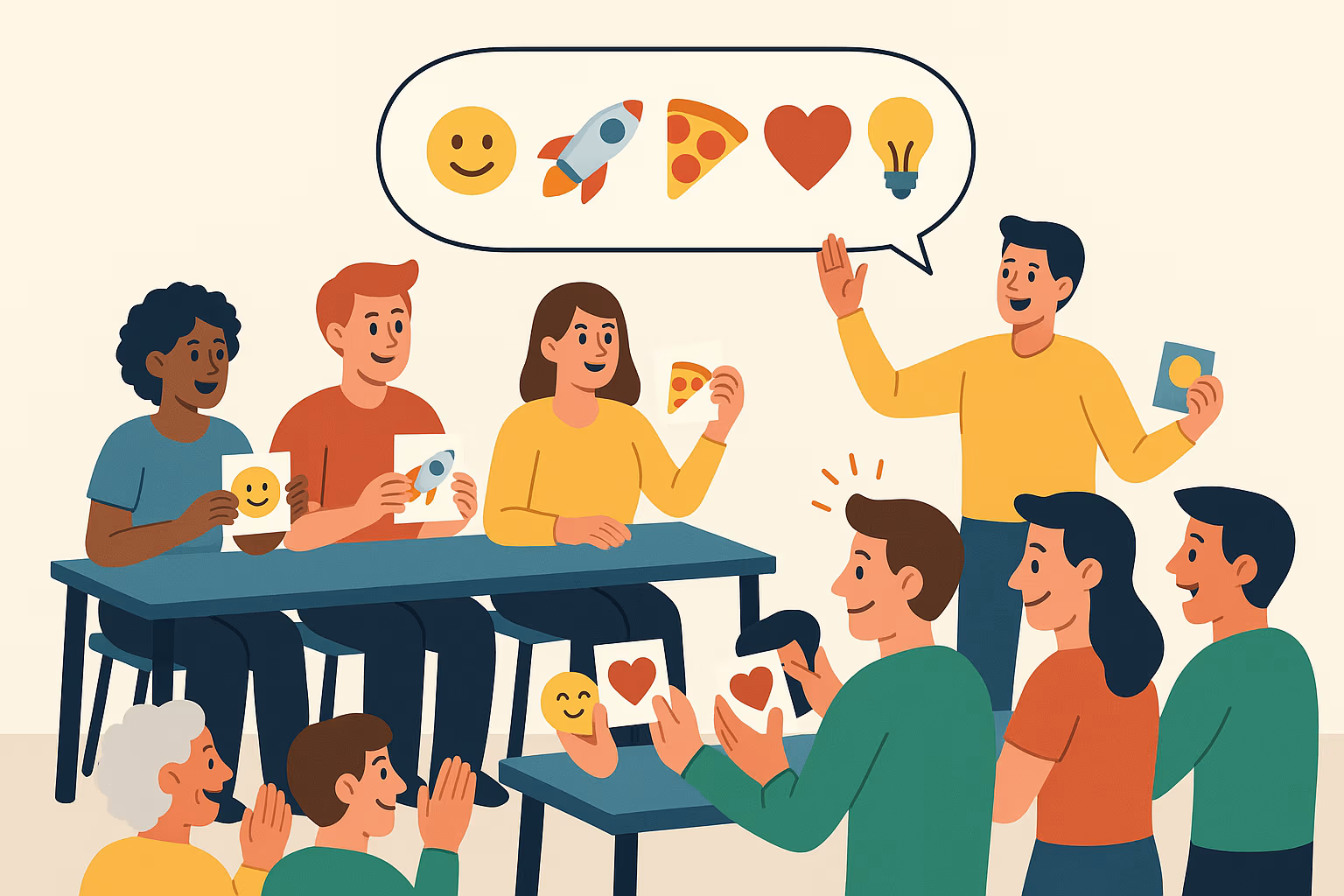
Overview:
A creative, fast-paced game where teams use random emojis to tell a story. Each group receives a set of emojis and must come up with a story that uses all of them. After a short prep time, teams present their stories while others guess the meaning. The most creative or entertaining story wins.
How to Play:
- Divide into small teams.
- Give each team a random set of emojis (printed or digital).
- Teams have 5–10 minutes to create a story using all their emojis.
- Each team presents their story to the group.
- The group votes on the most creative or compelling story.
Materials Needed:
- Emoji cards or digital emoji sets
Ideal Group Size & Setting:
Flexible for any size group. Works well in-person, remote, or hybrid.
Why It Works:
Builds communication and creative thinking, and helps remote teams connect in a fun, visual way.
8. Collaborative Mural Painting

Overview:
Teams work together to create a large mural, with each small group responsible for a section. The catch: no one sees the full design until all pieces come together. When assembled, the mural reveals a unified masterpiece—just like effective teamwork.
How to Play:
- Split the team into small groups.
- Assign each group a section of the mural to paint or draw.
- Groups work separately, focusing only on their section.
- Assemble all sections at the end to reveal the complete mural.
- Display the mural in a prominent spot as a reminder of teamwork.
Materials Needed:
- Canvas or large paper sheets
- Paints, markers, or other art supplies
- Tape or pins for assembly
Ideal Group Size & Setting:
Best for groups of 8–30. Perfect for in-person team building.
Why It Works:
Promotes collaboration, creativity, and big-picture thinking. Everyone contributes, regardless of artistic skill, and the finished mural becomes a lasting symbol of teamwork.
Problem-Solving Challenges That Build Real Skills
Team building exercises do more than just entertain - they mirror workplace challenges in controlled settings. Teams learn to tackle obstacles together and develop skills that they can use at work.
9. Marshmallow Tower
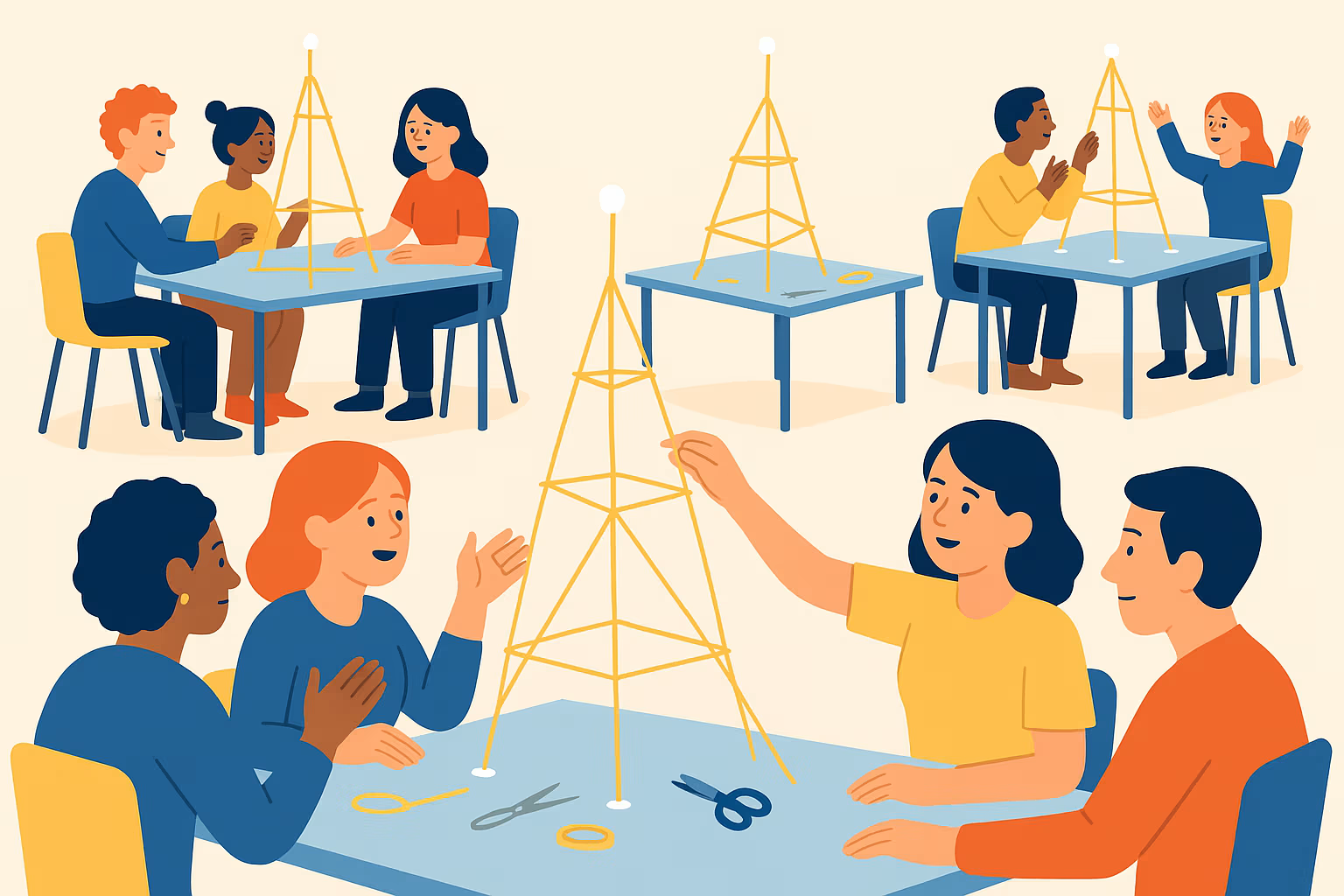
Overview:
Teams race to build the tallest free-standing tower using spaghetti, tape, string, and a marshmallow. The marshmallow must sit on top, and the structure has to stand on its own. This activity highlights the importance of prototyping, teamwork, and learning by doing rather than just planning.
How to Play:
- Divide participants into small teams.
- Give each team 20 spaghetti sticks, 1 yard (or meter) of tape, 1 yard of string, and 1 marshmallow.
- Set a timer for 18 minutes.
- Teams build the tallest tower possible, with the marshmallow on top.
- When time is up, measure each structure. The tallest standing tower wins.
Materials Needed:
- 20 spaghetti sticks per team
- 1 yard (or meter) of tape per team
- 1 yard (or meter) of string per team
- 1 marshmallow per team
- Scissors, measuring tape
Ideal Group Size & Setting:
Works best with 3–6 people per team. Suitable for in-person or hybrid events.
Why It Works:
Builds trust, encourages rapid prototyping, and shows that early testing often beats perfect planning. Teams practice communication, collaboration, and creative problem-solving.
10. Egg Drop Challenge
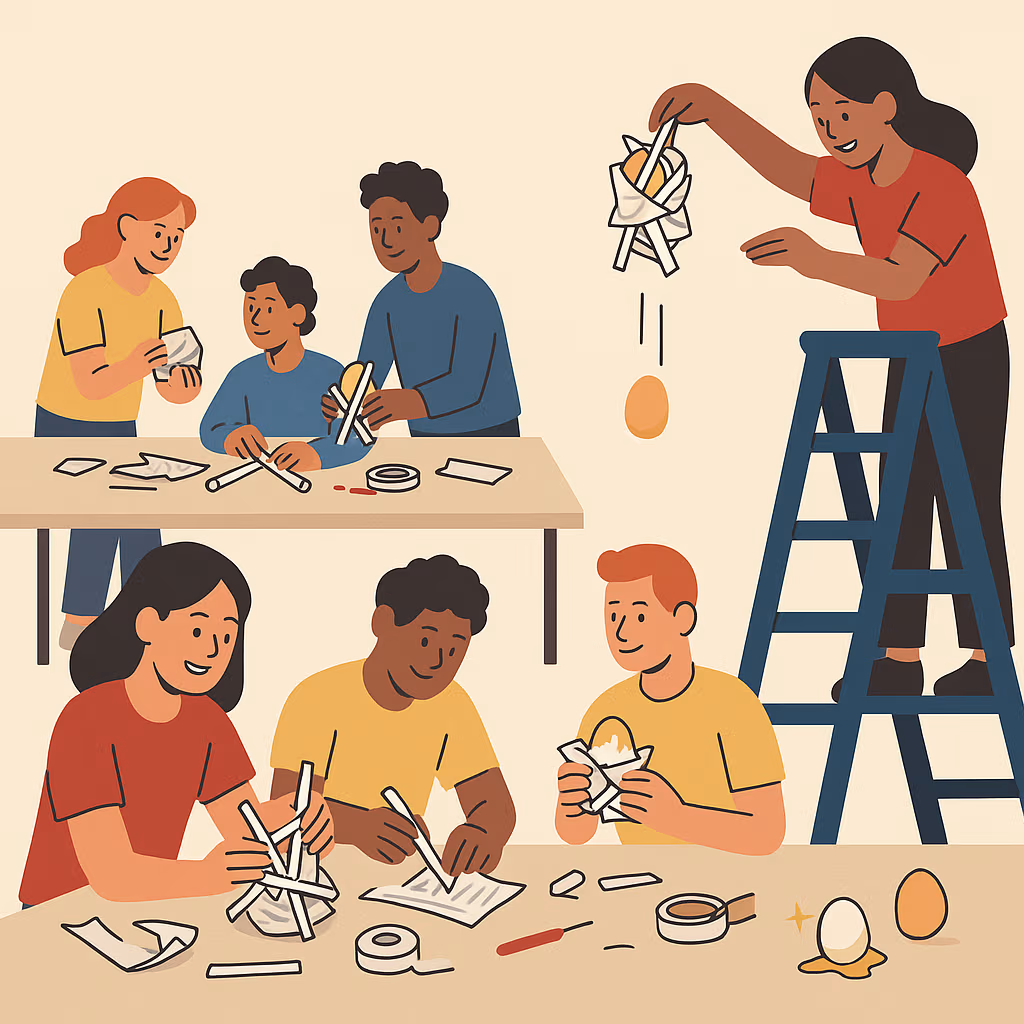
Overview:
Teams design and build containers to protect a raw egg from breaking when dropped from a height. Using simple materials, they must balance creativity and engineering basics to keep their egg safe.
How to Play:
- Form small teams and provide each with the same set of materials (e.g., newspaper, straws, tape).
- Teams have 20–30 minutes to design and build their protective container.
- Drop each container from a set height.
- Check which eggs survived the fall.
Materials Needed:
- Raw eggs
- Newspaper, straws, tape (equal amounts for each team)
- Scissors
Ideal Group Size & Setting:
Best for 3–6 people per team. Works well in-person or in a hybrid setting with access to materials.
Why It Works:
Promotes strategic thinking, teamwork, and creative problem-solving. Teams get instant feedback on their approach and learn to iterate and improve.
11. Barter Puzzle
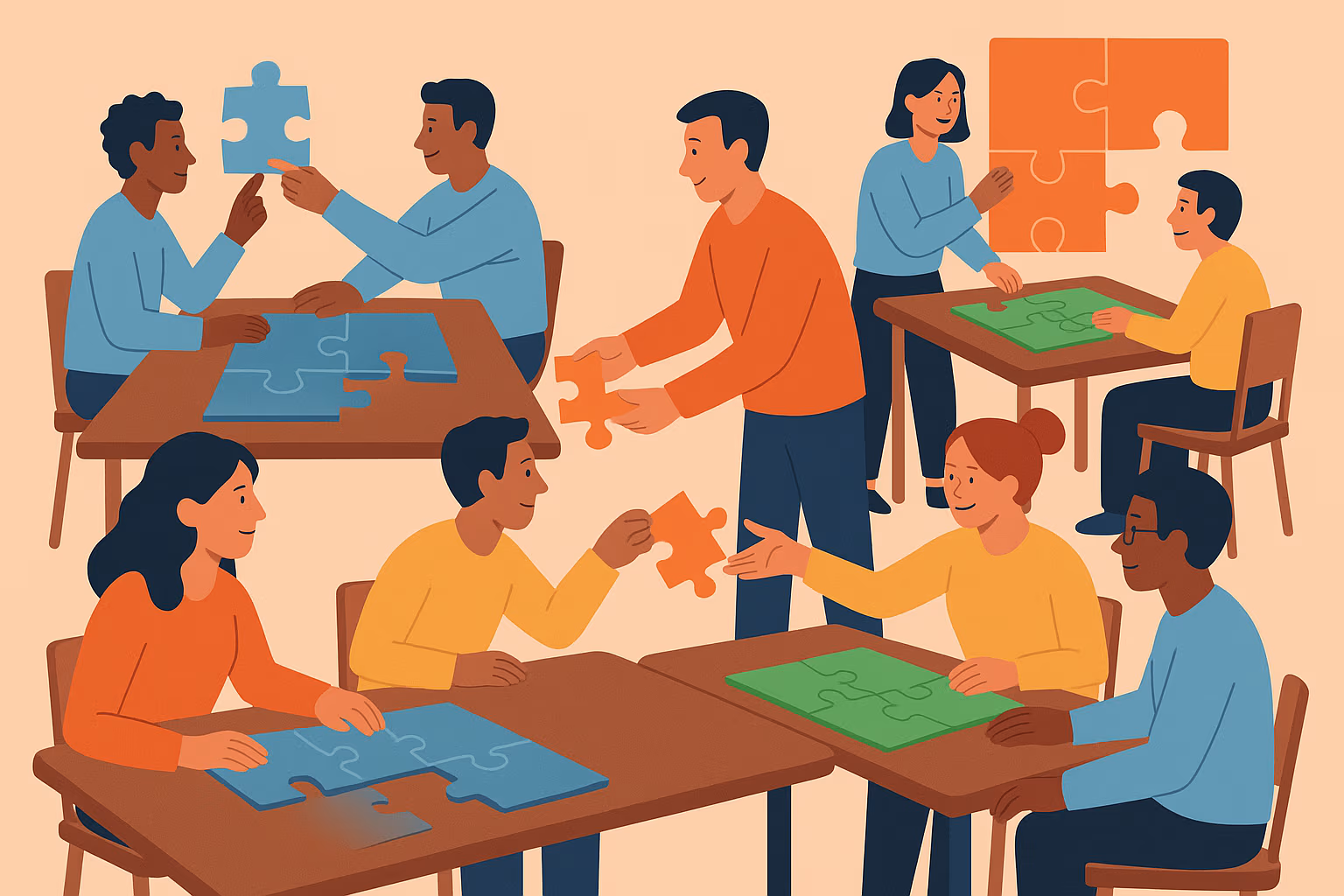
Overview:
Each team receives a jigsaw puzzle, but some pieces are mixed into other teams’ puzzles. Teams must negotiate, trade, or collaborate with others to complete their puzzle, practicing both problem-solving and negotiation skills.
How to Play:
- Divide participants into teams and give each a different puzzle (with some pieces swapped between puzzles).
- Teams work to assemble their puzzles, realizing some pieces are missing.
- Teams must negotiate, trade, or collaborate to get the pieces they need.
- The first team to complete their puzzle wins.
Materials Needed:
- Jigsaw puzzles (with pieces mixed between sets)
Ideal Group Size & Setting:
Works best with 3–5 people per team. Great for in-person or hybrid settings.
Why It Works:
Encourages negotiation, communication, and strategic planning. Teams learn to balance competition with cooperation.
Infographic illustration of teams exchanging jigsaw puzzle pieces in a Barter Puzzle team-building activity
12. Back of the Napkin

Overview:
Inspired by how many business ideas start, teams use a napkin and pen to sketch out solutions to a complex problem. This activity encourages creative thinking and visual communication.
How to Play:
- Divide into teams of 2–4.
- Give each team a folded napkin and a pen.
- Present a problem or scenario (business-related or imaginative).
- Teams have a set time to sketch their solution on the napkin.
- Teams share their ideas with the group.
Materials Needed:
- Napkins
- Pens
Ideal Group Size & Setting:
Best for small teams. Works in-person, hybrid, or virtually (using digital whiteboards).
Why It Works:
Promotes creativity, teamwork, and the ability to break down complex ideas into simple visuals—an essential workplace skill.
13. Tower Defense Game
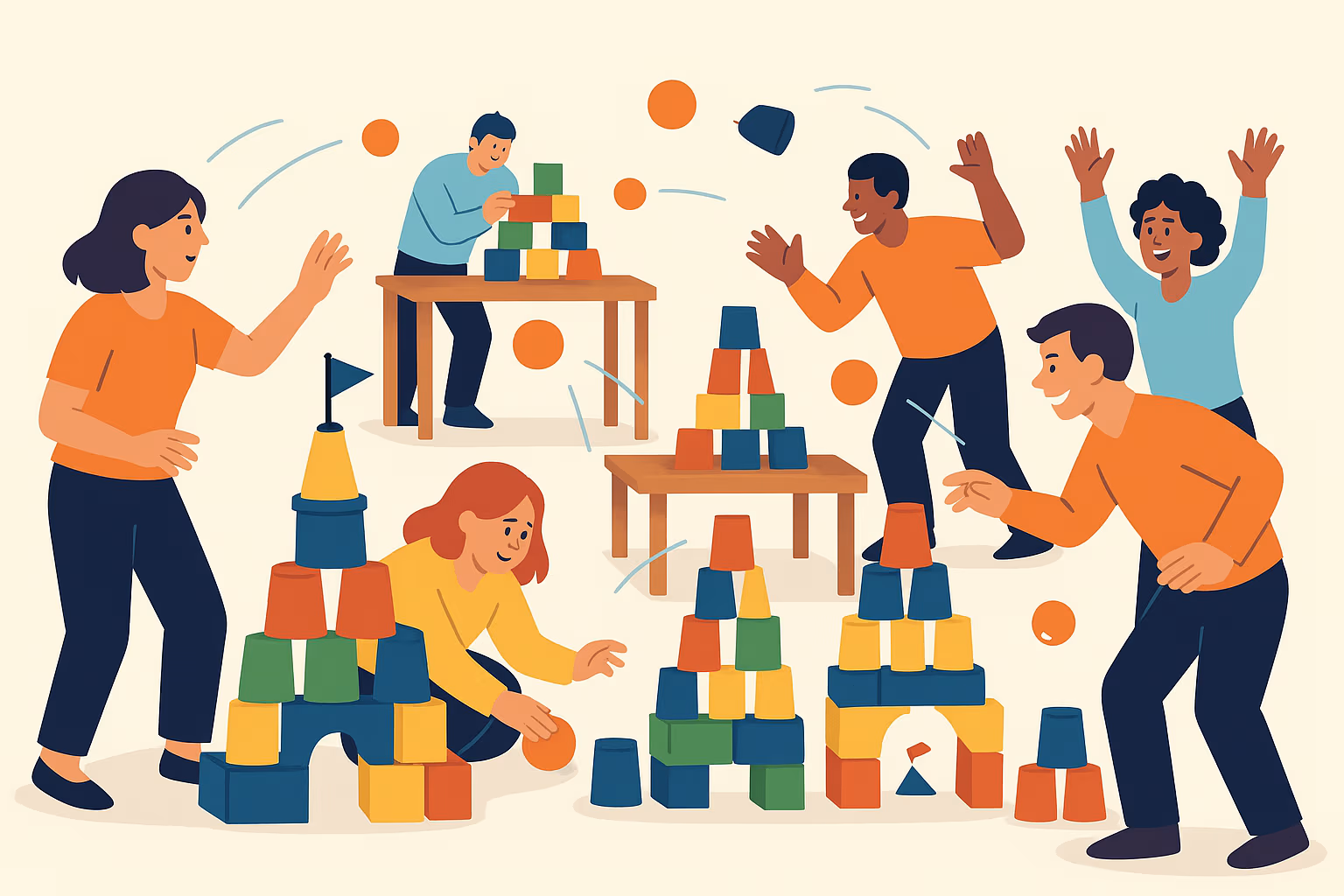
Overview:
Teams build defensive structures to protect against incoming “threats” using limited supplies. This real-world version of a popular strategy game teaches resource management and strategic planning.
How to Play:
- Divide participants into teams.
- Provide each team with building materials (e.g., blocks, cups, tape).
- Teams build a structure to defend a target (like a small object or “castle”).
- The facilitator or other teams try to knock down the structures with soft projectiles (like balls).
- After each round, teams can adjust their designs.
Materials Needed:
- Building materials (blocks, cups, tape, etc.)
- Soft projectiles (balls, beanbags)
Ideal Group Size & Setting:
Works well with small to medium teams. Best for in-person events.
Why It Works:
Builds teamwork, strategic thinking, adaptability, and communication under pressure.
14. Bridge Build
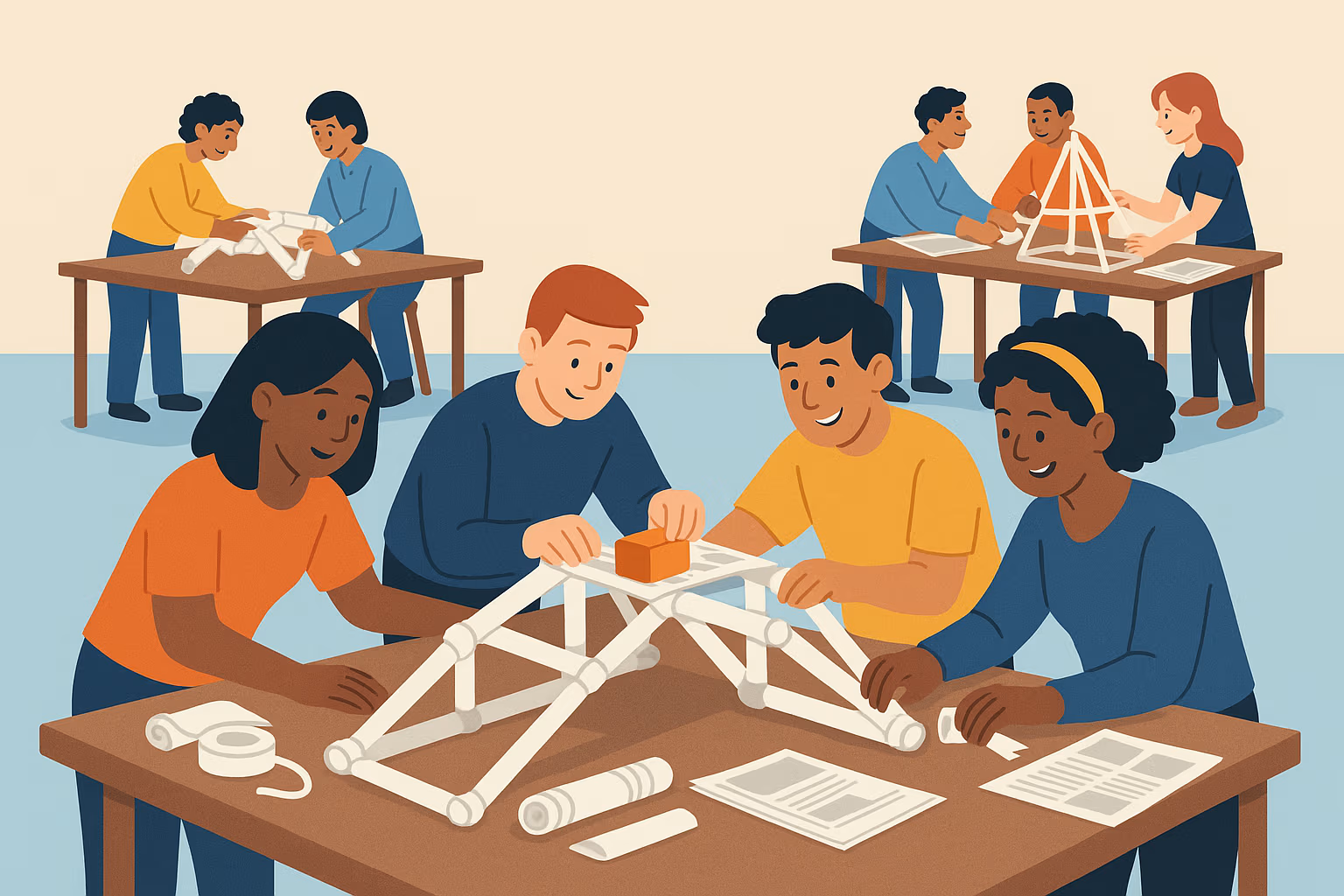
Overview:
Teams design and build bridges using basic materials. The goal is to create a bridge strong enough to support a specific weight, combining creative design with practical engineering.
How to Play:
- Split participants into teams.
- Give each team materials (e.g., newspaper, rope, insulation sheets).
- Teams have a set time to build a bridge.
- Test each bridge by placing weights or having a small object cross it.
Materials Needed:
- Newspaper, rope, insulation sheets (or similar materials)
- Weights or objects for testing
Ideal Group Size & Setting:
Best for 4–8 people per team. Ideal for in-person team building.
Why It Works:
Encourages collaboration, creative problem-solving, and balancing aesthetics with function—just like real project management.
Trust and Communication Exercises That Actually Work
Trust is the bedrock of high-performing teams, yet building it remains challenging in professional environments. These team building exercises create situations where teammates must depend on each other. The shared experiences naturally foster genuine trust.
15. Blindfold Challenge
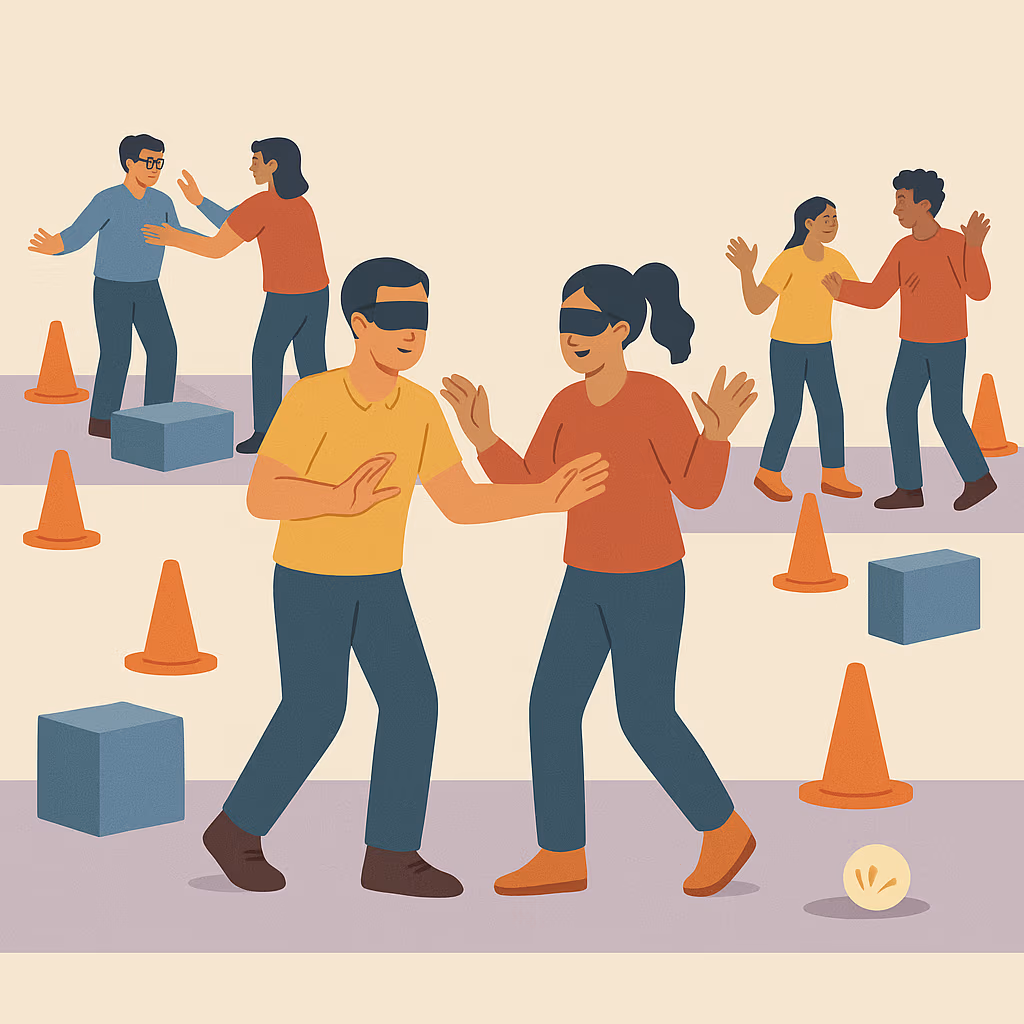
Overview:
Pairs work together as one person wears a blindfold and their partner guides them through an obstacle course. The blindfolded teammate relies completely on their partner’s verbal directions to avoid obstacles. This activity is all about building trust and sharpening communication skills.
How to Play:
- Set up a safe obstacle course using cones, boxes, or other simple objects.
- Divide the group into pairs.
- One person in each pair is blindfolded, while the other gives verbal instructions to guide them through the course.
- Switch roles so both partners experience guiding and being guided.
- The team that completes the course fastest or with the fewest mistakes can be recognized.
Materials Needed:
- Blindfolds
- Cones, boxes, or other safe objects for obstacles
Ideal Group Size & Setting:
Best for 8–16 people. Works well in-person, in a safe, open area.
Why It Works:
Builds trust and requires clear, precise communication. Guides quickly learn that unclear instructions can lead to mistakes, making this a practical lesson in teamwork.
16. Frostbite
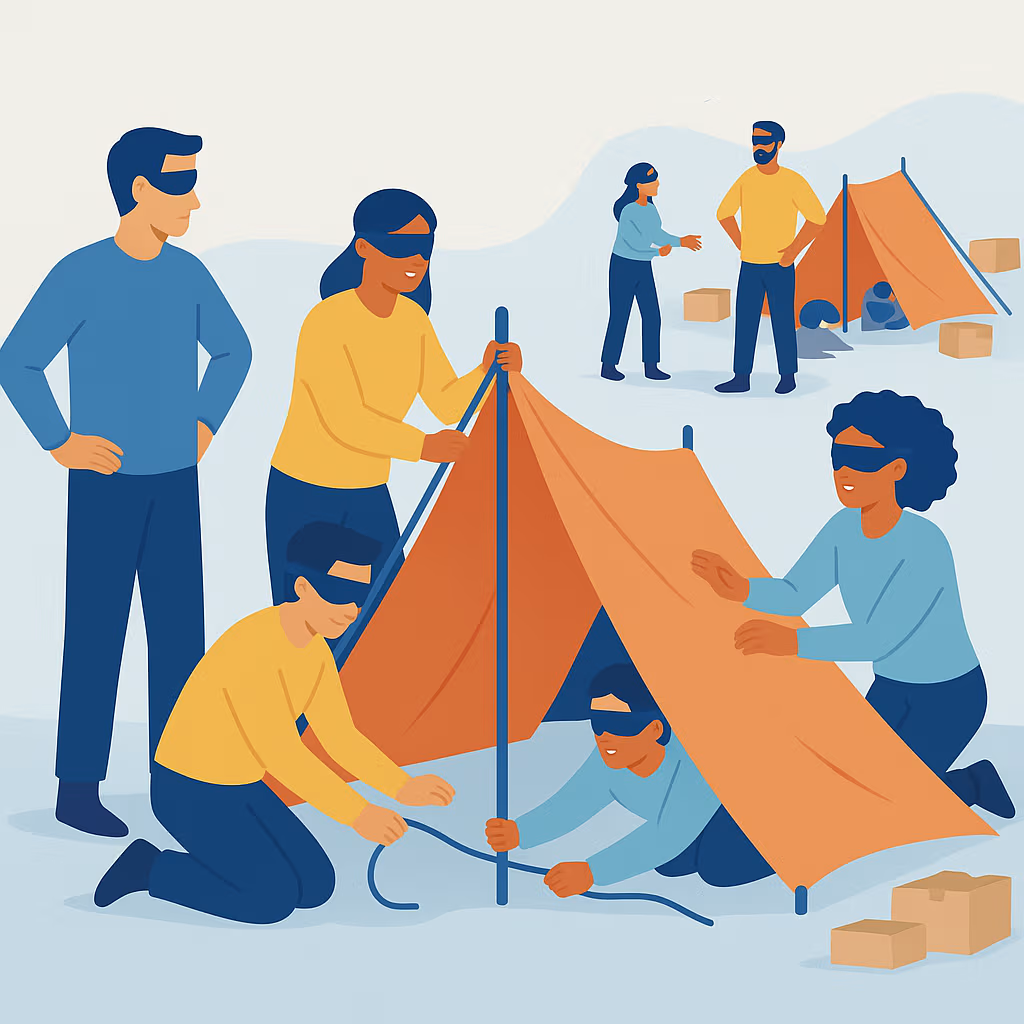
Overview:
Teams are put in an “arctic survival” scenario where the leader’s hands are “frozen” (they can’t use them), and the rest of the team is “snow-blind” (they wear blindfolds). The group must work together to build a shelter or tent, relying on communication and creative problem-solving.
How to Play:
- Divide participants into teams of 4–8.
- Each team selects a leader who cannot use their hands during the activity.
- The rest of the team puts on blindfolds.
- Teams have 30–45 minutes to build a shelter or tent using the materials provided.
- After time is up, review each shelter and discuss what worked and what didn’t.
Materials Needed:
- Blindfolds
- Tent or shelter-building materials (e.g., poles, tarps, ropes)
Ideal Group Size & Setting:
Works for 4–8 people per team. Best done in-person, indoors or outdoors with enough space.
Why It Works:
Develops communication, leadership, and adaptability. Teams must overcome physical limitations and rely on each other’s strengths.
17. Human Knot

Overview:
A classic team-building activity where 8–10 people stand in a circle, reach across to hold hands with two different teammates, and then try to untangle themselves without letting go. The group must communicate and work together to form a complete circle again.
How to Play:
- Have 8–10 participants stand in a circle.
- Everyone extends their left hand into the center and grabs someone else’s hand (not their neighbor’s).
- Repeat with right hands, grabbing a different person.
- Without letting go, the group works together to untangle the “knot” and form a circle.
Materials Needed:
- None
Ideal Group Size & Setting:
Best with 8–10 people. Works in-person, in any open space.
Why It Works:
Promotes communication, problem-solving, and collaboration. Success depends on everyone working together, not just individual effort.
18. Perfect Square
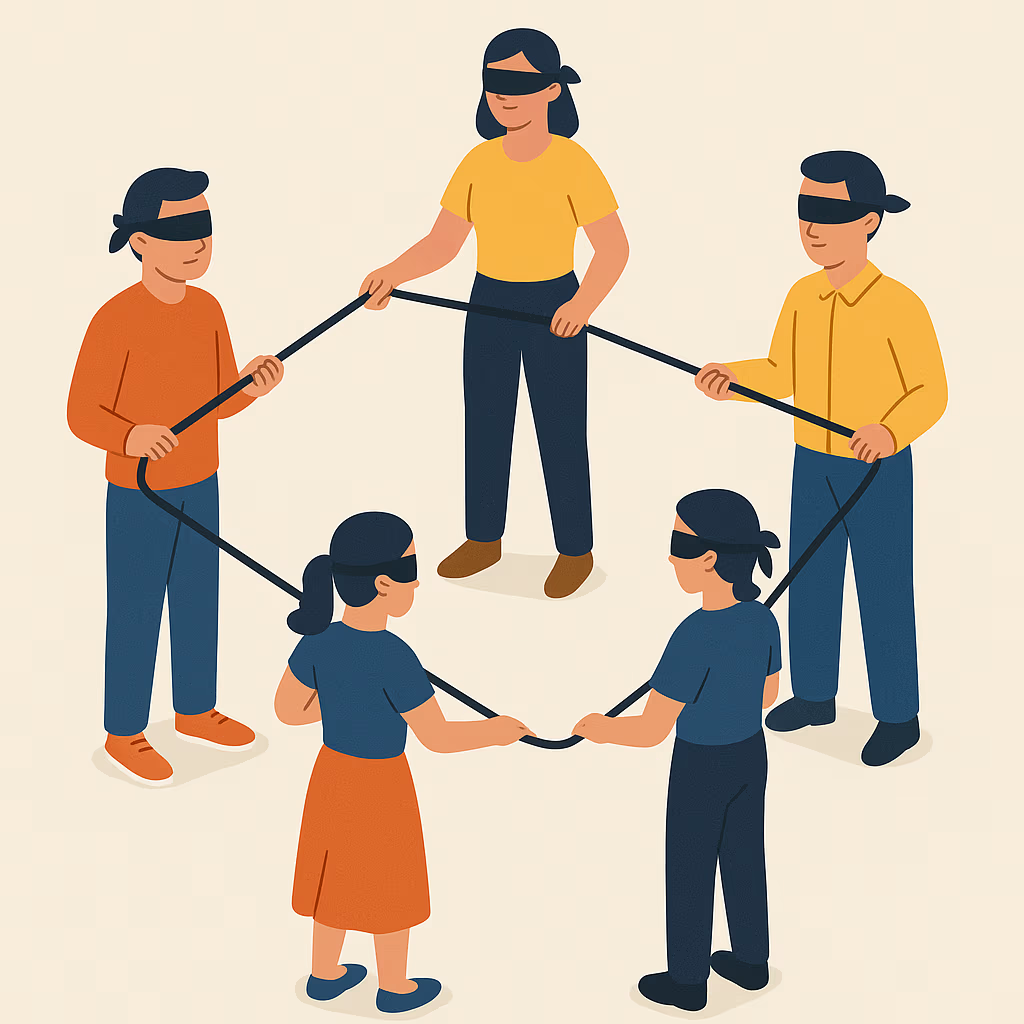
Overview:
Teams stand in a circle holding a rope, put on blindfolds, and try to form a perfect square. This activity tests communication and teamwork, especially when some members are asked to stay silent.
How to Play:
- Form a circle and have everyone hold onto a long rope with the ends tied together.
- Blindfold all participants.
- Instruct the team to form a perfect square with the rope while blindfolded.
- Allow communication, or add difficulty by making some members stay silent.
- Once the team believes they’ve made a square, remove blindfolds to see the result.
Materials Needed:
- Long rope (ends tied together)
- Blindfolds
Ideal Group Size & Setting:
Works best with 4–8 people. Suitable for in-person settings with enough space.
Why It Works:
Sharpens communication, cooperation, and creative thinking under constraints.
19. Tied Together
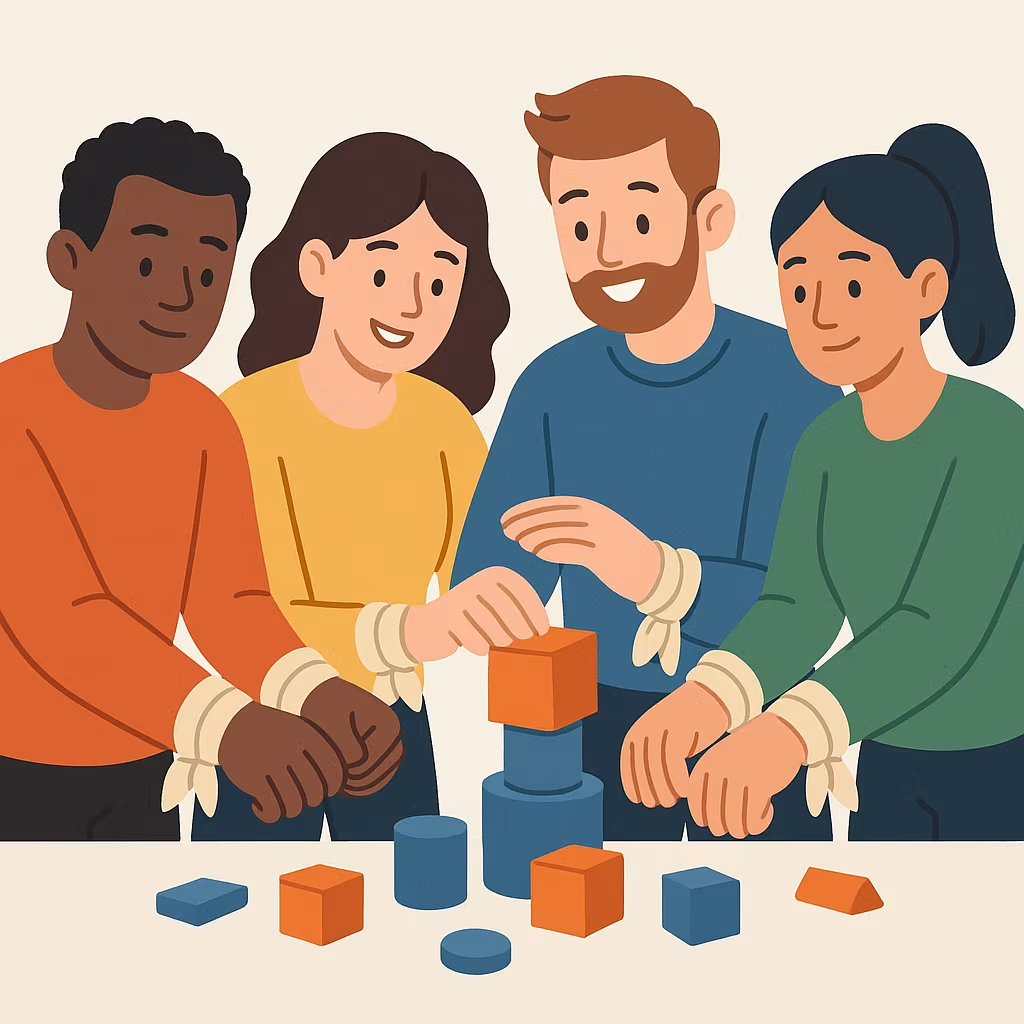
Overview:
This activity physically connects teammates by tying their wrists to their neighbors. The group must then complete simple tasks together, highlighting how interdependent team members are and building coordination.
How to Play:
- Form a circle and tie each person’s wrist to their neighbor’s using shoelaces, cloth strips, or zip ties.
- Place simple task materials (like Legos, wrapping paper, or cups) in the center.
- Teams must complete a series of tasks together while tied.
- Add a time limit for extra challenge.
Materials Needed:
- Shoelaces, cloth strips, or zip ties
- Items for simple tasks (blocks, cups, etc.)
Ideal Group Size & Setting:
Works best with 6–12 people. Best for in-person team building.
Why It Works:
Builds teamwork, coordination, and communication. The shared challenge creates lasting memories and strengthens collaboration.
Virtual Team Building Activities for Remote Teams
Remote work just needs fresh approaches to team connection. Physical distance shouldn't stop us from building meaningful bonds through virtual team building activities that address the unique challenges of distributed teams.
20. Virtual Escape Room
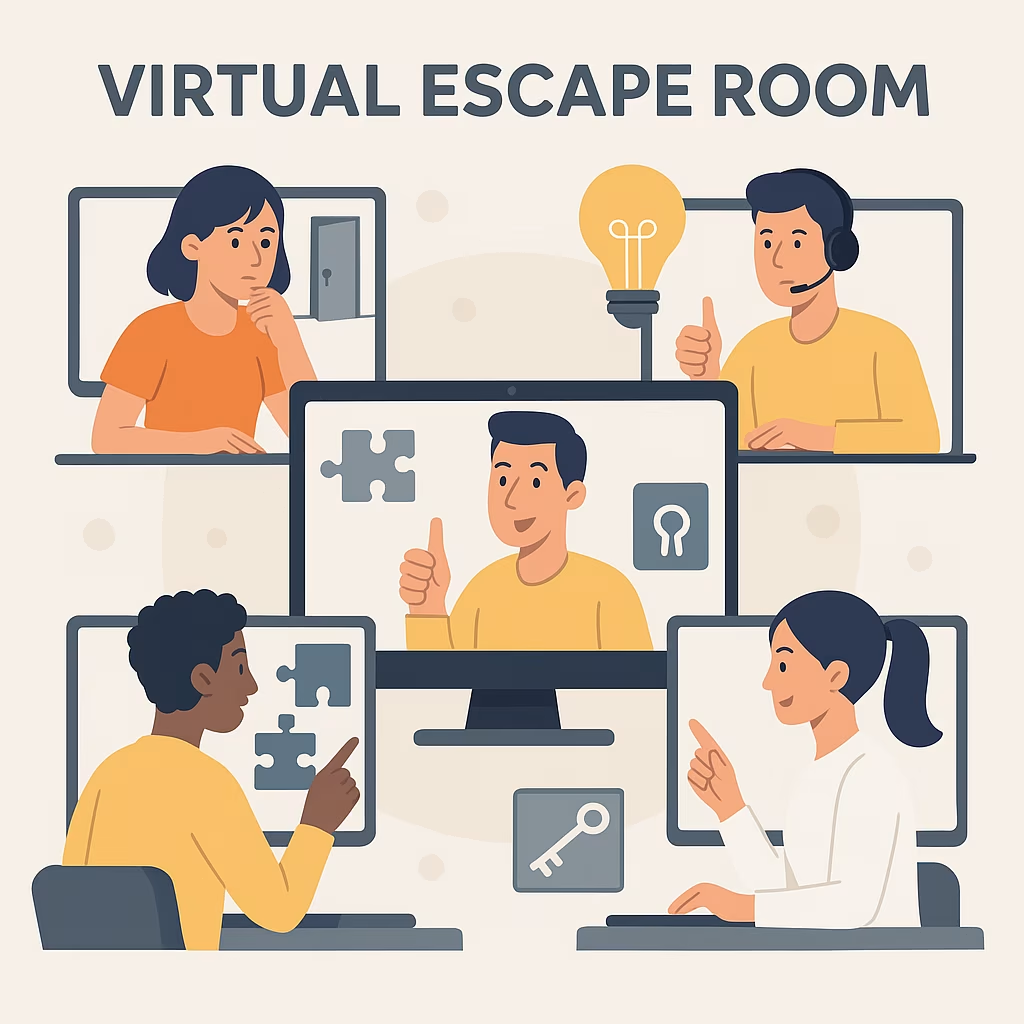
Overview:
A virtual escape room is an online adventure where teams work together to solve puzzles and “escape” within a set time. These games are designed for remote teams and recreate the excitement of in-person escape rooms, challenging everyone to communicate, think creatively, and collaborate under pressure.
How to Play:
- Divide participants into small teams (usually 4–8 people per team).
- Each team joins a video call and is guided by a host or game master who sets the scene and explains the rules.
- Teams explore a digital environment, solve riddles, and crack codes by discussing clues and sharing ideas.
- The goal is to “escape” before time runs out, usually within 60–90 minutes.
- After the game, teams can debrief and share what strategies worked best.
Materials Needed:
- Computer or device with internet access
- Video conferencing platform
- Access to a virtual escape room game or service
Ideal Group Size & Setting:
Perfect for remote or hybrid teams of any size (can scale up to hundreds by splitting into smaller groups).
Why It Works:
Builds problem-solving, communication, and teamwork skills. Teams learn that success depends on working together, not just individual smarts.
21. Online Trivia Showdown
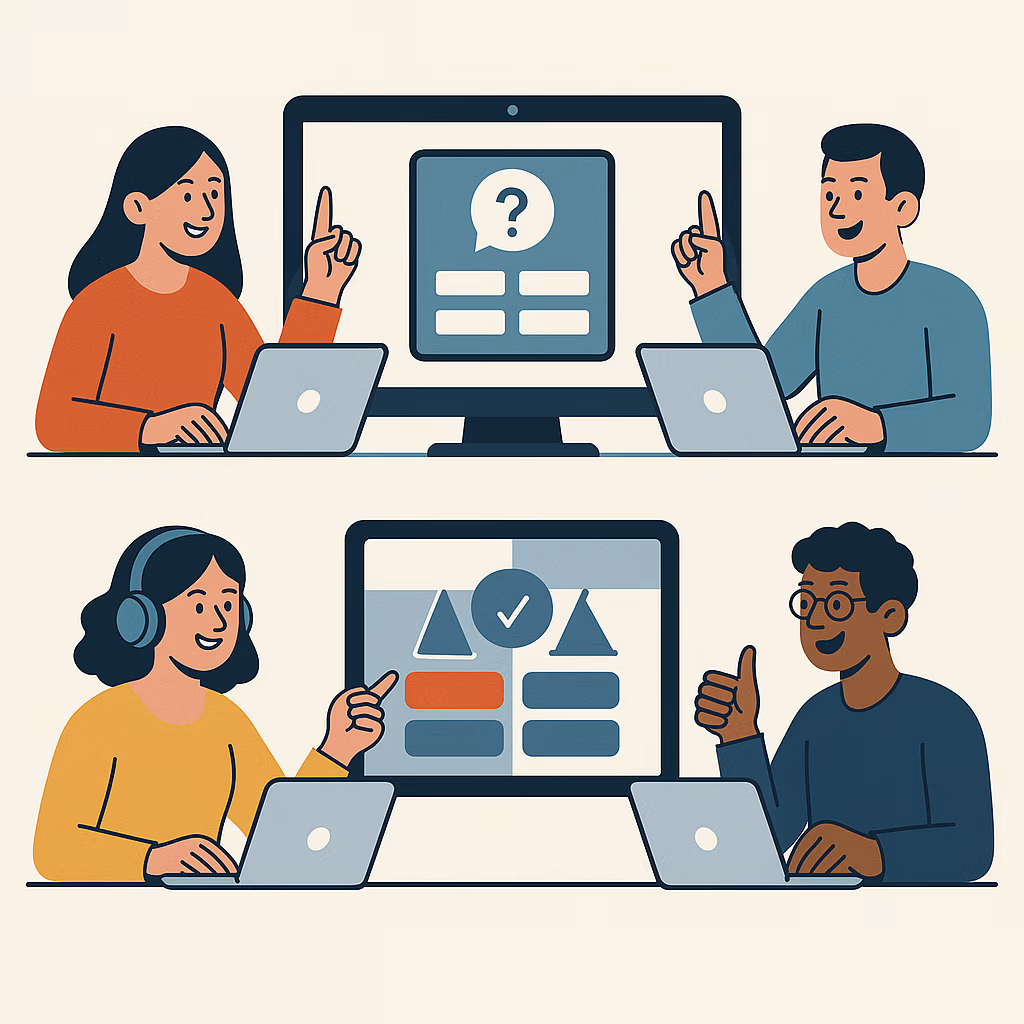
Overview:
An online trivia showdown is a fast-paced, virtual quiz game where teams compete in themed rounds of questions. It’s a fun way to spark friendly rivalry, test knowledge, and bring remote colleagues together.
How to Play:
- Organize participants into teams.
- Use a trivia platform or share questions via video call.
- Play several rounds, each with a different theme (pop culture, company facts, industry knowledge, etc.).
- Teams discuss and submit their answers within a time limit.
- Keep score and announce the winners at the end.
Materials Needed:
- Video conferencing tool
- Trivia questions or an online trivia platform
Ideal Group Size & Setting:
Works for remote or hybrid teams of any size; best with 3–8 people per team.
Why It Works:
Encourages teamwork, quick thinking, and friendly competition. Custom categories can boost engagement and make the game more relevant to your team.
22. Show and Tell

Overview:
Show and Tell brings a personal touch to virtual meetings. Team members take turns sharing a meaningful item from their home and telling its story. This simple activity helps everyone learn more about each other and builds empathy.
How to Play:
- Ask participants to prepare a personal item to share (e.g., a souvenir, photo, favorite book).
- Each person has 1–3 minutes to show their item on camera and explain its significance.
- After each presentation, others can ask questions or share related stories.
- Continue until everyone has had a turn.
Materials Needed:
- Video conferencing platform
- Personal items from home
Ideal Group Size & Setting:
Best for small groups (6–15 people). Works in any virtual meeting.
Why It Works:
Promotes connection, empathy, and natural conversation. Team members get to know each other beyond work roles.
23. Coffee Roulette

Overview:
Coffee Roulette randomly pairs team members for virtual coffee breaks, mimicking the spontaneous chats that happen in the office. These informal video calls help remote colleagues connect and get to know each other in a relaxed setting.
How to Play:
- Use a tool or manual process to randomly match employees for short, one-on-one or small group video calls.
- Schedule 15–30 minute sessions focused on casual, non-work topics.
- Rotate matches regularly so everyone meets new colleagues over time.
Materials Needed:
- Video conferencing platform
- Coffee or beverage of choice
Ideal Group Size & Setting:
Great for any team size. Works especially well for remote or hybrid teams.
Why It Works:
Breaks down communication barriers, reduces feelings of isolation, and builds a culture of inclusivity and engagement.
24. Lip Sync Battle

Overview:
A virtual lip sync battle brings energy and laughter to remote teams. Participants record themselves lip-syncing to their favorite songs, often adding creative dance moves or costumes. The videos are shared with the team for everyone to enjoy and vote on.
How to Play:
- Invite team members to choose a song and record themselves lip-syncing.
- Collect and compile the videos into one fun showcase, or play them live during a virtual meeting.
- Team members vote for the most entertaining, creative, or funny performance.
- Announce winners and celebrate together.
Materials Needed:
- Video conferencing tool
- Music and recording devices (smartphones or computers)
Ideal Group Size & Setting:
Works for any team size. Perfect for remote or hybrid teams looking for a high-energy, creative activity.
Why It Works:
Boosts morale, encourages creativity, and helps team members let loose and bond in a fun, memorable way.
How to Choose the Right Team Building Activity
Picking the right team-building activity needs smart planning, not just what seems fun. Your choice could make all the difference between time wasted and real team growth.
1. Team size and location matter
Your group's size affects which activities will succeed. Small teams of under 10 people do better with intimate activities that let everyone take part. Bigger groups need activities split into smaller units so each person feels included and can participate.
The venue plays a crucial role, too. Office-based teams thrive with physical activities that promote movement. Remote teams need digital options that work well online. Hybrid teams should look for flexible formats that work well no matter where people join from.
2. Link activities to your goals
A clear objective stands as the most important part of team-building planning. You should ask: What specific challenge needs attention? Each goal needs its own approach:
- Communication barriers need activities with precise instructions
- Departmental silos work best with cross-functional challenges
- Innovation blocks respond well to creative exercises with multiple solution paths
Clear goals help activities line up with real team needs, which makes them more influential and meaningful to everyone involved.
3. Mix fun with purpose
The best team-building games hit the sweet spot—fun enough to draw people in, yet meaningful enough to bring real benefits. One operations manager puts it well: "It's all about striking that perfect balance between fun and purpose."
Each part of your activity should boost both involvement and growth. This doesn't mean boring exercises dressed up as games. Instead, create thoughtful experiences where fun naturally builds skills.
4. Listen to your team
Post-activity feedback helps make future events better. You can learn through:
- Anonymous surveys that measure satisfaction and value
- Net promoter scores that show the likelihood of recommendations
- One-on-one talks during regular check-ins
Companies that collect and use feedback create better team experiences that truly help with changing team needs.
Note that successful team-building activities don't follow a standard formula. They need careful selection based on your team's unique makeup and challenges.

Final Thoughts: Making Team Building a Habit, Not a One-Off
Team building isn’t just a one-time event—it’s a business essential. When you match the right activities to your team’s needs and make them a regular habit, you’ll see stronger connections, more innovation, and better results. Focus on the 7 C’s, listen to your team, and keep building those bonds—your organization’s success depends on it.
Exciting team-building activities are a great way to energize your workplace and strengthen team bonds. If you’re unsure where to start or which activities will truly engage your group, don’t worry. Use personalized surveys—like those from ThriveSparrow—to discover exactly what your team enjoys. This approach ensures you always choose activities that match your team’s interests, making every team-building session both fun and effective.
FAQs
Q1. What are some effective team-building activities for remote teams?
Virtual escape rooms, online trivia competitions, and virtual coffee roulette are great options for remote teams. These activities foster collaboration, boost morale, and create shared experiences despite physical distance.
Q2. How can team-building activities improve workplace performance?
Team-building activities can enhance communication, foster trust, and develop problem-solving skills. They also help break down departmental silos, uncover hidden talents, and strengthen organizational culture, all of which contribute to improved workplace performance.
Q3. What should I consider when choosing a team-building activity?
Consider your team size, location (in-person or remote), specific goals, and the balance between fun and purpose. It's also important to gather feedback from your team to ensure the activities are relevant and engaging.
Q4. How often should team-building activities be conducted?
Team building should be an ongoing process rather than a one-time event. Regular activities, even if they're short and simple, can help maintain team cohesion and continuously improve workplace dynamics.
Q5. Can team-building activities really impact a company's bottom line?
Yes, effective team building can have a significant impact on a company's performance. Research shows that organizations prioritizing team connection see increased innovation, reduced absenteeism, and improved retention rates, all of which positively affect the bottom line.
















